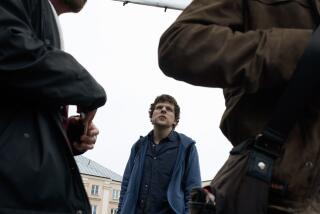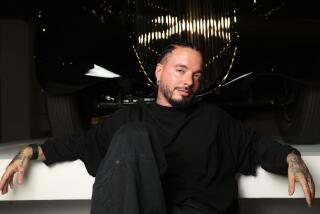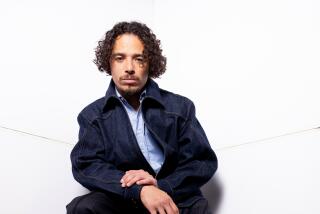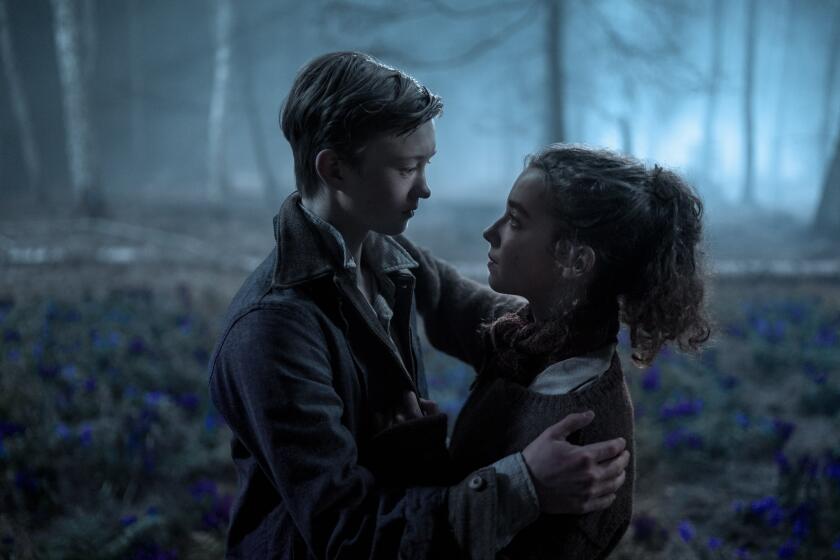The Sequel: Gibson Behind the Camera : Movies: After directing and starring in ‘Man Without a Face,’ he knew what to expect when he took on those chores--and added producing--for ‘Braveheart.’
FORT WILLIAM, Scotland — Here’s Mel Gibson on the set of his new movie--starring, directing and making it all look pretty easy.
Pacing himself through a long, grueling day, Gibson has it down pat. Maintaining a director’s vision from in front and behind the camera? No worries. Management of cast and crew, and interpersonal skills? A breeze.
No, it’s midgies that are proving the problem.
Midgies? That’s the nickname given by local Scots to small, gnat-like insects with a ferocious bite that leaves their human victims scarred and scratching for weeks if they wander around these parts without insect repellent.
“They won’t be deterred,” Gibson says with a sigh. “I’ve felt them bite me, but I don’t react as badly as some people to them.”
The midgies are especially prevalent in Glen Nevis, a valley shrouded in low clouds where Gibson and crew are filming; it lies below Ben Nevis, at 4,406 feet Britain’s highest peak. For much of the time light drizzle falls in the glen. As soon as it stops, the midgies emerge to do their malevolent work.
Glen Nevis might seem an inhospitable place to make a movie, but Gibson has opted for authenticity. This $35-million production is “Braveheart,” the story of William Wallace, a 13th-Century rebel hero who roused local clans into an attempt to drive the English under King Edward I from Scotland. Gibson plays Wallace; his company, Icon, which he formed with his associate Bruce Davey, is producing “Braveheart” for Paramount to distribute in the United States (it is due for release in early May) and Fox in the rest of the world.
“I’ve been sitting on this script for two years,” says Gibson. “It was written by Randall Wallace, who’s a country boy from Tennessee. He might be descended directly from William Wallace and the Wallace clan, he just doesn’t know.
“When I first read Randy’s script, something about it haunted me. It wasn’t quite there yet, but it had a real good heart. The execution could have been better, but Randy’s great. His gift is that he’s passionate. What came through in that script was his heart, his genuineness.”
Gibson and Davey sat down with Wallace over a period of several months to amend the “Braveheart” script. “It’s an insanely heroic story,” Gibson says. “It falls somewhere between fact and legend. He existed, but there were a lot of legendary stories about him. One of them claimed he was 6 foot 6, but that’s pretty unlikely. He may have been around 6 foot, which was very tall for the time.
“Wallace is a footnote in most historical accounts, but I’ve read history books written specifically about him, insisting he was a lot more than a footnote.”
In fact, Wallace’s efforts failed and he was hanged, drawn and quartered by Edward and his followers. Gibson insists “Braveheart” will reflect that fact. “No happy Hollywood ending,” he says flatly. “Though at the same time I do think there’s a lot of victory in it. The things Wallace started germinated after his death.”
To play Wallace, Gibson is employing a light Scots brogue that will be quite comprehensible to American audiences. On the whole, he says, the Scots he has met have welcomed the fact that a film is being made of Wallace’s life, even if Gibson, an Australian American, is playing him.
“I haven’t experienced any animosity or disapproval,” he says. “Maybe a few sly chuckles. They wouldn’t do it in front of you anyway.” He lapses into his dialect with a grin: “It haaapens at yer baaack.” Some Scottish commentators have advanced the opinion that Sean Connery, the world’s most famous Scottish actor, should play Wallace, but Gibson, as tactfully as he can, points out an age problem: Wallace was executed while still in his 30s.
Gibson has deliberately opted for a gritty approach to his subject. He is wearing tartan, true, but not the neat, bright-colored checks that American tourists now associate with Scotland. Instead he is wearing drab colors--greens, browns and earth tones--with sacking lashed to his ankles by cords.
“This was camouflage, originally,” he says. “They just used whatever colors were around in the countryside. These guys used to blend in--you couldn’t see them coming. They were hairy and dirty, just like this.” Gibson points to himself; he has been strategically smeared with mud and dirt by makeup artists, who have added a few bloody scratches on his arms and legs. He also wears a long auburn wig that trails below his shoulders; from one temple, his hair hangs in a small plait.
Across the valley the “Braveheart” construction crew has created a 13th-Century Scottish village, consisting of huts overlooked by a wooden fortress. Several scenes have been shot here, but today the village is to be burned to the ground by English soldiers on horseback, wielding fiery torches.
Gibson looks on approvingly. “I haven’t seen the 13th Century done like this (on film),” he says. “Most movies of the period have big castles, but in reality it wasn’t so. Castles came later.
“You look at this village, that fort, and you figure the people who lived in a place like this were eating raw meat, almost. But you need to make it look real, so you know you’re not watching ‘Brigadoon.’ ”
*
In his trailer, Gibson is close to the jokey persona he inhabited in “Maverick” and the quieter moments of the “Lethal Weapon” films, full of self-deprecation and a penchant for puns that make the listener groan. Yet, watching him at work, it’s hard to escape the notion that he sees himself as the complete filmmaker.
For a scene in a grassy wood that involves him on camera, his veteran English first assistant director David Tomblin shouts, “Action!” and “Cut!”--then Gibson scoots down a hillock to see the scene replayed on a monitor. It is his decision alone whether a take should be printed, and his eye for detail means the scene is shot repeatedly until he is satisfied. The members of the mainly British crew were handpicked for their long experience: “It’s no accident they’re here,” Gibson says.
He functions as lead actor and director by day, then at night after rushes have been shown (a Fort William distillery doubles as an editing suite), Gibson turns producer, viewing rushes of another Icon film shooting in Prague, “Immortal Beloved,” starring Gary Oldman as Beethoven (it opened in December).
It makes for a long day. “Yeah,” says Gibson, “there’s nothing more satisfying than crawling into bed at night and not wanting to do anything but go unconscious.” (His wife, Robyn, and their six children are with him in Scotland.)
He has already doubled as actor and director in “Man Without a Face,” which was reasonably successful. “This time it seems easier to me because it’s charted waters,” he says. “I knew what it was going to take out of me, and on the first one I didn’t expect that. It’s all about preparation, and for me you’ve got it beat if you can prepare properly.”
In the past he has spoken of feeling like an outsider in Hollywood (“Who wouldn’t feel one?”), but is now clearly at a stage in his career where he is fully involved and learning to work the system.
“Yes,” he agrees cautiously, “but it’s a curious system, Hollywood. Just by stepping out there and trying it on, you learn a little more about what it is and what makes it tick. You never get to the bottom of it, but that’s the main point--it’s imponderable. So you leave doors and options open and stay prepared for all sorts of weirdness. Yet it’s the same for everyone over there--the people you think are doing the weirdness are getting weirdness done to them too.”
So he still feels a detachment? “Oh, you must. You set certain ethical parameters for what Icon does. Icon has rules. They’re not written out someplace, but by virtue of the people involved, whose talents are used to get something done and not screw anyone over.”
Yes, but what do Icon films actually stand for? “There’s a definite want to make quality pictures,” Gibson says. “They don’t have to be serious, thoughtful, meaningful message pictures, just well-made and entertaining. Anything, any subject matter, could come within that realm.” Like “Maverick”? “Sure. It’s just a giggle. That’s what it’s for.”
He goes on in this vein, describing Davey as the business brain behind Icon and characterizing himself as “a fiscal imbecile.” He states firmly that he will do no more “Lethal Weapon” films, admits that he might do non-Icon films for a studio if the role is right. Then suddenly his mobile phone rings.
It’s first A.D. David Tomblin, asking how crowded the upcoming scene of “Braveheart” should be. “A few women, half a dozen children,” says Gibson briskly. “I’ll be right there.” He looks apologetic: “Gotta go.”
And Mel Gibson--star, director, producer--leaps from his trailer and strides off toward the set for another afternoon of involved problems and complex decisions.
If only the midgies will stay away.
More to Read
Only good movies
Get the Indie Focus newsletter, Mark Olsen's weekly guide to the world of cinema.
You may occasionally receive promotional content from the Los Angeles Times.










